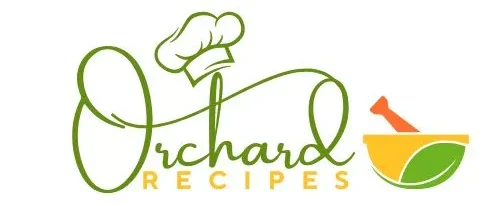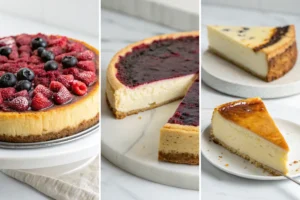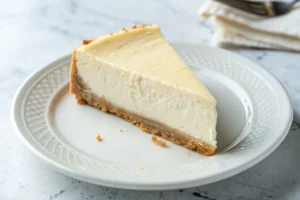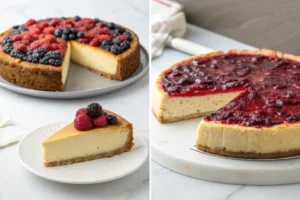Introduction
Cheesecake, a timeless classic, stands as a testament to the art of simple indulgence. This velvety dessert, with its rich flavors and varied textures, has captivated taste buds across the globe. But did you know that there’s more to this decadent treat than just a creamy filling on a crumbly base? In fact, there are three primary types of cheesecake, each offering a unique experience. This article will take you on a delightful journey, exploring these different styles, unveiling their secrets and allowing you to discover your ideal cheesecake. From the dense, classic indulgence to the easy-going, no-bake varieties, get ready to now what are the three types of cheesecake? and dive into the world of cheesecake.
Baked Cheesecake: The Classic Choice
What Defines a Baked Cheesecake?
Baked cheesecake is fundamentally a cooked custard dessert; bakers carefully craft it through oven baking. The key lies in incorporating eggs into the cream cheese filling; this process not only binds the ingredients but also contributes to its signature texture. When baked, this mixture transforms into a firm yet tender treat. Baking is essential for achieving the creamy texture and a slightly caramelized top. To ensure a perfectly baked treat, we recommend using a springform pan; this helps in removing the dessert from the pan without breaking it.
Key Characteristics
The hallmark of a baked cheesecake lies in its luxuriously dense and creamy texture. It boasts a smooth, even consistency that is quite distinct from its no-bake counterparts. The baking process itself imparts a unique, slightly caramelized top layer, offering an intriguing contrast to the creamy interior. This top layer is a result of the Maillard reaction, where sugars on the surface start to brown and create a richer flavor profile. Moreover, a crucial step in achieving this texture is allowing the cheesecake to cool completely after baking; in fact this rest solidifies the filling, resulting in the desired texture. Sometimes, it is common to find little cracks on top while baking the cheesecake, but don’t worry it is normal.
The New York Style Cheesecake: A Prime Example
Perhaps one of the most iconic types of baked cheesecake is the New York-style cheesecake. This is certainly a beloved variety, known for its incredibly dense and rich flavor. The extra creaminess, is achieved by incorporating sour cream or heavy cream into the batter, resulting in a distinct, tangy flavor. Its appearance is also as striking as its flavor, often towering high with an imposing presence, making it look as good as it tastes. The New York cheesecake is often baked with a graham cracker crust that provides a crunchy contrast to its rich filling. You can find this version of cheesecake almost anywhere, from your local bakery to high-end restaurants.
Other Variations
While the New York variety often steals the spotlight, there are many variations of baked cheesecake. For example the Philadelphia cheesecake is a popular version known for its simplicity and tangy flavor. Another variety that deserves our attention is the Italian-style cheesecake, which usually incorporates ricotta cheese into the mixture, resulting in a slightly different and interesting texture and flavor profile. The Japanese cheesecake, is known for its lighter and fluffier texture, which is very different from other cheesecakes and is known for its melt-in-your-mouth sensation. Finally, we can always find other diverse inclusions in baked cheesecakes, from lemon zest to vanilla extract, or chocolate to fruit, offering a unique experience for everyone.
No-Bake Cheesecake: The Quick and Easy Delight
What is No-Bake Cheesecake?
The name “no-bake cheesecake” tells you it’s a chilled dessert, and it avoids baking in an oven. Instead, it builds its structure through the use of gelatin or similar setting agents. This means the no-bake cheesecake uses the power of chilling, not heat, to set. This process transforms the creamy mixture into a firm yet smooth dessert, making it both delicious and incredibly convenient to prepare.This is an excellent option for individuals who are hesitant about baking, or who just don’t want to turn on the oven.
The Texture and Flavor Profile
People often describe a no-bake cheesecake’s texture as creamy and smooth; however, it tends to be lighter than baked cheesecakes. Because it lacks baking, it presents a less dense consistency, which offers a unique mouthfeel. The best part is that you can customize its flavor profile to your liking with endless possibilities. Its refreshing and cool sensation makes it ideal for warmer days. You can also easily shift its flavor from classic vanilla to chocolate, from rich caramel to fruity delights.
How to Prepare a No-Bake Cheesecake
To prepare a basic no-bake cheesecake, you will first start by making a crust using crushed graham crackers or biscuits combined with melted butter. You then press this mixture down into the bottom of your chosen pan. Following this step, you need to prepare the cream cheese mixture, which is made with cream cheese, sugar, and flavorings. A setting agent such as gelatin is then incorporated into the batter to set the filling, this is crucial to achieving the desired consistency. Finally, pour the mixture over the crust and refrigerate it, usually for at least a few hours for a smooth and set texture. This is indeed a fun recipe to make with kids.
Advantages
No-bake cheesecake’s main advantage is its quick preparation time. It’s a great dessert for those who want a sweet treat without spending too much time in the kitchen. This cheesecake is super convenient for beginner bakers because they face less risk of failure compared to traditional methods. It also stands out as an excellent choice for warm weather or when you prefer not to use the oven. Moreover, its simplicity and low risk of failure make it a popular choice for both novice and experienced bakers alike. Furthermore, its adaptability to many flavors makes it a versatile option for dessert lovers.
Basque Cheesecake: The Burnt Beauty
What is Basque Cheesecake?
The Basque cheesecake is a fascinating departure from the usual cheesecake styles. Originating from Spain, this rustic variety stands out due to its distinctive, crustless nature. What truly sets it apart is its intentionally burnt surface, a characteristic that might seem like a mistake but is actually a crucial element of its appeal. The dark, caramelized top not only looks unique but also plays a key role in its flavor profile, differentiating it from other cheesecakes. It’s a bold and unapologetic dessert that celebrates simplicity and imperfection.
Texture and Flavor of Basque Cheesecake
The interior of a Basque cheesecake is wonderfully creamy and custardy, offering a stark contrast to its dramatically burnt exterior. This interplay of textures is one of its most intriguing aspects; as you sink your teeth into it, you experience a slight bitterness from the caramelization and then a rich, creamy interior. The caramelized flavor enhances the overall taste, adding a level of sophistication. Although it might have a burnt top, the inside remains light and airy, creating a unique melt-in-your-mouth sensation. It is definitely a delightful experience.
Preparing and Serving Basque Cheesecake
The preparation of a Basque cheesecake is quite straightforward, but it requires a specific technique to achieve its signature look. The high oven temperature during baking is vital in creating that beautifully burnt top. The use of parchment paper lining the pan is essential to prevent the cheesecake from sticking and to allow the edges to bake freely, creating a rustic appearance. Unlike many other cheesecakes, Basque cheesecake is often served slightly warm or at room temperature, which enhances its creamy texture. This cheesecake is truly a celebration of embracing imperfections while being a delicious treat.
Cheesecake Classification: Beyond the Three Main Types
A Look at Cheesecake Categories:
While the three main types of cheesecake—baked, no-bake, and Basque—provide a solid foundation for understanding this dessert, cheesecakes can be further classified in multiple ways. Cheesecakes can be categorized by their cooking method, as we’ve seen: baked, no-bake, and chilled versions. Another form of classification relies on the texture, where some are dense, others airy, while some are light and creamy. And of course, cheesecakes are often categorized based on their flavor variations, such as fruity, chocolate, or caramel; offering a huge versatility. By understanding these different classifications, we can truly appreciate the wide variety of cheesecakes available.
Regional and International Varieties:
Moving beyond the traditional American styles, there is a whole world of cheesecakes to explore, each with unique characteristics. For example, the Italian version, often made with ricotta cheese, offers a lighter, tangier alternative to the typical cream cheese-based varieties. Then, there is the Japanese cheesecake, recognized for its fluffy and spongey texture, which is quite different from others. Furthermore, the rustic and less sweet Basque version with its caramelized top offers a different experience that stands out. These are just some examples of how diverse and adaptable this dessert can be. Indeed, the world of cheesecake is rich and full of surprising and delightful variations.
The History of Cheesecake: A Sweet Journey
Ancient Origins of Cheesecake:
The story of cheesecake begins far before its modern variations. Indeed, the history of cheesecake can be traced back to ancient times, with early versions found in ancient Greece. These early cheesecakes were simple concoctions, made with basic ingredients like cheese, honey, and flour. They were quite different from what we now know as cheesecake, but it’s fascinating to see the origin. In essence, the ancient Greeks pioneered a form of what we now know as a classic dessert, thus laying the foundation for this beloved treat that has made its way to kitchens and tables around the world.
Cheesecake Through the Ages:
Over the centuries, the cheesecake has undergone quite an evolution. From its humble beginnings in ancient Greece, it gradually evolved through the times into the delicious variety of textures and tastes we see today. As it moved across different cultures, the ingredients and preparation methods adapted, resulting in different types of cheesecakes. The popularity growth of cheesecake around the world is a testament to its versatility and appeal. Its adaptation in different cultures highlights the global love for this delicious dessert. It’s a journey through history, that takes you to the current version of the dessert.
New York vs. Chicago Style Cheesecake: A Tale of Two Cities
New York Style: Dense and Creamy:
The New York-style cheesecake is often considered the quintessential baked cheesecake, and it’s easy to see why. It is renowned for its incredibly dense texture and rich flavor. These characteristics make it incredibly unique. It is the use of sour cream and heavy cream that provides the extra flavor that gives this cheesecake its distinct tang. The New York cheesecake is the embodiment of creamy indulgence, which makes it a favorite. Its iconic presence in restaurants and bakeries makes it one of the most popular and widely recognized varieties available around the world.
Chicago Style: Lighter and Taller
In contrast to its dense cousin, the Chicago-style cheesecake presents a lighter, and airier texture. This style of cheesecake is known for its taller profile. Made with eggs and milk in addition to cream cheese, this approach produces a light texture that many find appealing. It is also an extremely popular variation, although it is not as widely distributed as New York style. Chicago cheesecake thus offers an alternative style to its New York cousin, giving a lighter and more airy option that caters to different tastes.
Choosing the Right Type of Cheesecake for Your Taste
Considerations for Selecting a Cheesecake:
When it comes to choosing the right type of cheesecake, there is no one-size-fits-all solution. The best option will be based on your individual flavor and texture preferences. If you like a rich and dense dessert, the New York-style or other types of baked cheesecakes might be your best bet. However, if you are looking for something lighter, a no-bake option or the Basque cheesecake could be more appealing. It is also important to consider the ease of preparation and time involved, where the no-bake cheesecake is a great quick solution. Ultimately, what makes a cheesecake perfect comes down to your personal preferences.
Matching Cheesecake to the Occasion:
The type of cheesecake you choose can also depend on the occasion. For a quick and easy dessert, a no-bake cheesecake is a fantastic option, allowing you to whip up something delicious without spending hours in the kitchen. Baked versions, such as the New York cheesecake, are ideal for more formal gatherings, elegant dinners, or special celebrations. For something unique and sophisticated, the Basque cheesecake can surely impress and delight. In short, by carefully considering the situation and the palate, you can match the cheesecake to any occasion perfectly.
FAQs about What are the three types of cheesecake?
-
What are the best types of cheesecake?
-
The “best” type of cheesecake is truly subjective and depends on individual preference. However, popular and highly regarded options include the New York-style cheesecake for its richness, the Basque cheesecake for its unique flavor, and no-bake cheesecake for convenience. It all comes down to what you like the most.
-
-
What is the classification of a cheesecake?
-
Cheesecakes are generally classified based on various factors, such as their cooking method: baked, no-bake, and chilled. They can also be classified by texture, such as dense, airy, and light. Finally, flavor variations also provide a base for classification.
-
-
What was the first type of cheesecake?
-
The earliest form of cheesecake can be traced to ancient Greece. The ingredients were quite basic, with cheese, honey, and flour. This version is quite different to the ones we know today.
-
-
What is the difference between New York and Chicago style cheesecake?
New York and Chicago-style cheesecakes differ mainly in their texture and ingredients; New York cheesecake’s rich, dense, and creamy texture comes from sour cream and heavy cream, while Chicago-style cheesecake is lighter, airier, and taller due to the use of eggs and milk.
Conclusion of What are the three types of cheesecake?
The world of cheesecake is vast and varied, offering a delightful experience for every palate. This article has explored the three main types of cheesecake: the classic baked cheesecake, the quick and easy no-bake cheesecake, and the unique Basque cheesecake. Each type has its own distinct characteristics, from texture and flavor to preparation method. The baked cheesecake, with its dense and rich profile, stands in contrast to the lighter and easier no-bake cheesecake. The Basque cheesecake offers its own uniqueness with its burnt top and custardy interior. We hope you will try different varieties to find your personal favorite. And remember that no matter the type, cheesecake remains a versatile dessert that is perfect for any occasion.
Now what are the three types of cheesecake?




